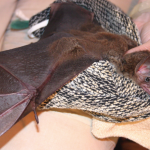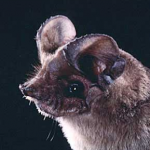Order Chiroptera: Bats
An Introduction to our Flying Friends, the Bats!
In total, there are about 1100 bat species in the world. They live in every continent in the world except for Antarctica. Since the dawn of creation, people have been captivated by these amazing, flying, nocturnal creatures; stories of them have been told for centuries. Accounts have been recorded from the Romans to the Mayans, and legends of vampires have sprung from their existence.
In reality, bats are misunderstood creatures of the night. Our goal is to dispel their myths by giving the facts of their winged existence.

Bats are nocturnal, meaning they prefer to rest in the daytime and leave their roosts at night in search of food. In the day they stay hidden from predators, choosing to roost in caves and man-made structures like bridges and dilapidated buildings. Some bat species are solitary, while others may live in large colonies with thousands or millions of individuals.
Of the many amazing things about bats are their unusual and unique adaptations. To suit their nocturnal lifestyle bats take advantage of echolocation to find food and locate their way in the dark. Echolocation is like the sonar used by dolphins but is detected very differently in these airborne creatures. Because of their need for echolocation, bats have evolved a variety of unique facial appearances: tube-nosed bats, leaf-nosed bats, large-eared spotted bats, and more! Many bat species also hibernate, and many species have developed unique ecological adaptations including diet and habitat preference.
Finally, bats have unique and important ecological roles. Some bats prey on mammalian blood while some bats pollinate night blooming plants. Bats that prey on flying insects can be extremely valuable in reducing insect populations; they may eat up to four times their body weight in insects every night!
Taxonomy and Classification
While there are around 1100 recorded bat species in the world, we are still discovering new species. The name for this mammalian order is Chiroptera, meaning “winged hands” in Latin. Within this order bats can be divided into two primary suborders, the Megachiroptera and the Microchiroptera.
Megachiroptera: Large, Old World, Fruit-Eating Bats
The sub-order Megachiroptera is composed of Old World Bats that are mostly fruit-eaters. They range primarily in Africa, Asia, Australia, and Oceania. One can recognize these bats by large body mass, large eyes, long-snouts, and wings that wrap around their body as they roost. Generally, they lack the ability to echolocate and instead find their food by sight. A good example of a Megachiroptera is the flying fox.
Family Pteropodidae (Old World Fruit Bats)
Microchiroptera: Echolocating Bats
The much more diverse Microchiroptera are generally smaller and often insectivorous. They are found throughout the world, with the exception of cold polar extremes. Since these bats locate food with echolocation, they have larger ears and noses and smaller eyes. While most bats in this sub-order feed on insects, some have adapted to feed on pollen, fruit, fish, and even blood.
The 18 families found in both sub-orders make about 1100 bat species. Bat diversity is highest in the tropics. On one small island in Panama, for instance, there are 74 species of bats; the entire United States has just 47. Similarly Mexico has 137 species; Canada has only 20.
Family Antrozoidae (Pallid Bats)
Family Craseonycteridae (Bumblebee Bat)
Family Embalonuridae (Sac-Winged Bats, Sheath-Tailed Bats, … )
Family Furipteridae (Smoky Bats, Thumbless Bats)
Family Hipposideridae (Leaf-nosed Bats, Roundleaf Bats, and Trident Bats)
Family Megadermatidae (False Vampire Bats)
Family Molossidae (Free-Tailed Bats)
Family Mormoopidae (Ghost-faced Bats, Mustached Bats, and Naked-Backed Bats)
Family Mystacinidae (New Zealand Short-Tailed Bats)
Family Myzonodidae (Old World Sucker-Footed Bat)
Family Natalidae (Funnel-eared Bats)
Family Noctilionidae (Bulldog Bats)
Family Nycteridae (Slit-faced Bats)
Family Phyllostomidae (New World Leaf-Nosed Bats)
Family Rhinolophidae (Horseshoe Bats)
Family Rhinopomatidae (Mouse-tailed Bats)
Family Thyropteridae (Disc-Winged Bats)
Family Vespertilionidae (Evening Bats and Vesper Bats)
Adaptations
Bats have evolved a great deal of adaptations to survive in varied conditions across the globe. There are frugivorous species and species that feed only on blood. Some species are large while others are as small as five grams. Some bats are pollinators, and some bats are predators. In fact, the variety of food sources and the choice of roost locations reflect how varied the adaptations of bats are.
All bats are mammals, but they are one of the few that have evolved the ability to fly. While bat wings may at first make one think they are similar to other flying creatures, they are not related. The anatomy of a bat’s wings is very different than those of a bird or insect. Just as the name for this order (Chiroptera: “winged hands”) may imply, the bones of the wings are elongated fingers. Simpy imagine for a second that your fingers were much longer and connected by flaps of skin. Bat wings are very similar. In fact, their webbing attaches from their fingers to their ankles. This creates a fold that can wrap around their body when roosting. This membrane thus connects their hands, legs, and tails and allows for incredible maneuverability in bats. Many species of bat rely on this maneuverability to catch small insects, such as moths, mosquitoes, wasps, and other fliers in the night sky.
Another adaptation that bats have is the ability to hibernate when the seasons change. But it doesn’t matter if a bat lives in cold areas. Even tropical species of bat have this ability. It’s thought that they have this adaptation to help deal with low abundance of food, such as a seasonal lack of insects or fruit. They do this by dropping their core body temperature, which reduces energy loss. It’s thought that some bats induce hibernating by moving up-slope to cooler elevations.
Select Bat-watching sites in the United States
Alabama: Hambrick Cave and Blowing Wind Cave (Gray Bat)
California: Point Reyes National Seashore (Townsends’s Big-eared Bat + 14 more species)
Missouri: Rock Bridge Memorial State Parke (Gray Bats and Indiana Bats)
New Mexico: Bandelier National Monument and Carlsbad Caverns National Park (Mexican Free-tailed bat + 14 more)
Tennessee: Nickajack Cave (Gray Bat)
Texas: Congress Avenue Bridge in Austin, Eckert James River Bat Cave, and Old Tunnel Wildlife Management Area (Mexican Free-tailed Bats)



































































































